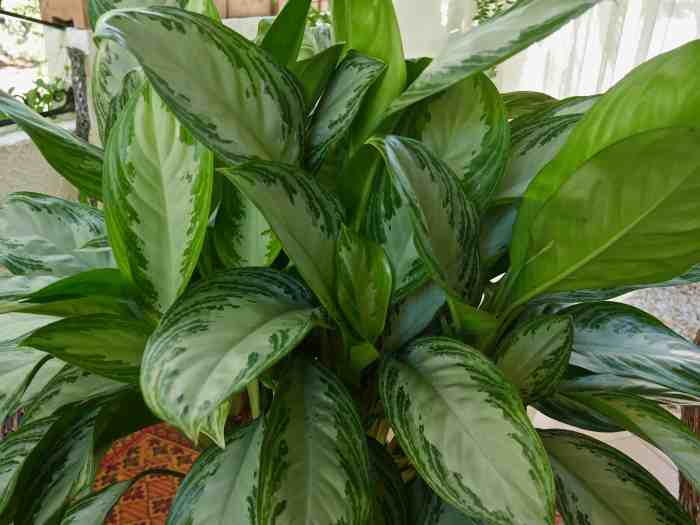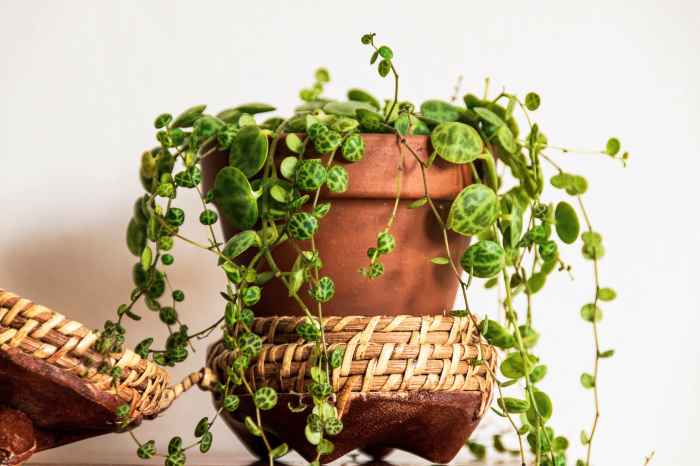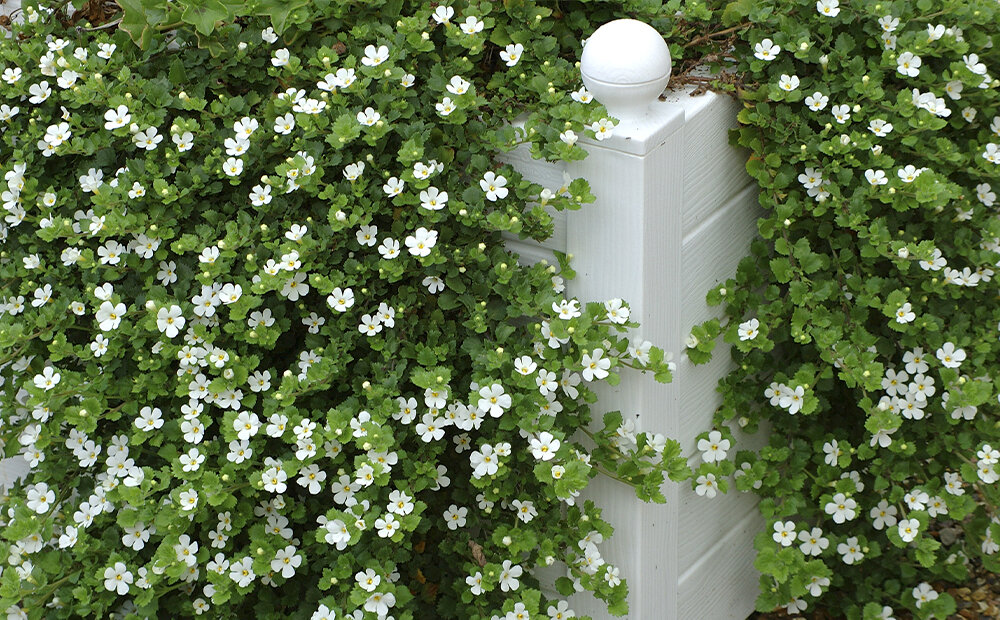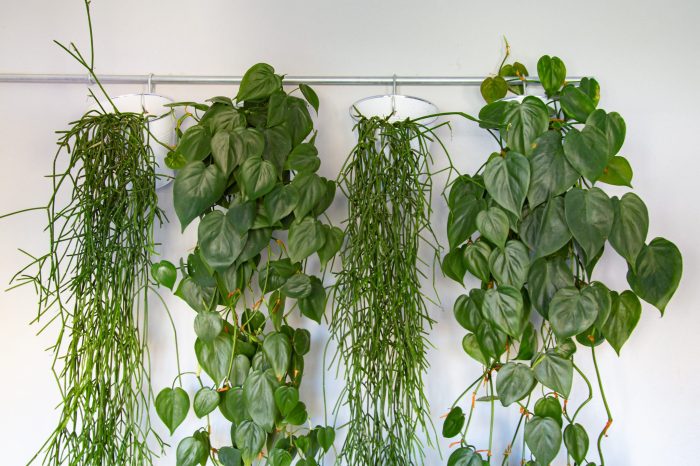Embark on a journey into the world of easy trailing plants, where cascading greenery transforms ordinary spaces into captivating havens. These versatile plants, with their graceful tendrils and lush foliage, offer endless possibilities for indoor and outdoor décor.
Discover the art of incorporating trailing plants into your surroundings, creating breathtaking displays that enhance aesthetics, purify the air, and bring a touch of nature’s tranquility indoors. Whether you’re a seasoned plant enthusiast or a budding gardener, this comprehensive guide will equip you with the knowledge and inspiration to cultivate thriving trailing plants.
Popular Easy Trailing Plants for Beginners

Embark on your plant-parenting journey with these easy-care trailing plants, perfect for beginners seeking lush greenery without the hassle. These versatile plants add a touch of elegance to any space, cascading over shelves, hanging baskets, or windowsills with minimal effort.
Their forgiving nature makes them ideal for those with busy schedules or limited experience. Whether you’re a seasoned green thumb or just starting out, these trailing wonders will bring joy and vitality to your indoor oasis.
Pothos
- A classic choice for beginners, Pothos is known for its heart-shaped leaves that come in a variety of colors, from vibrant greens to variegated patterns.
- It thrives in bright, indirect light but can tolerate low-light conditions, making it suitable for a wide range of spaces.
- Water when the soil feels dry to the touch, and fertilize monthly during the growing season.
String of Pearls
- With its delicate, bead-like foliage, String of Pearls is a unique and charming addition to any collection.
- It prefers bright, indirect light and well-draining soil.
- Water sparingly, allowing the soil to dry out completely between waterings.
Spider Plant
- Spider Plants are known for their long, arching leaves that produce plantlets, creating a cascading effect.
- They are highly adaptable and can tolerate a range of light conditions, from bright to low light.
- Water when the top inch of soil feels dry, and fertilize monthly during the growing season.
Decorating with Trailing Plants
Trailing plants, with their cascading foliage, offer a unique and eye-catching way to add greenery to indoor and outdoor spaces. Their ability to drape over containers, trellises, and hanging baskets makes them a versatile addition to any décor.
If you’re looking for easy trailing plants to add a touch of greenery to your home, you may want to consider the easiest hanging houseplants . These plants are known for their hardiness and low maintenance requirements, making them a great choice for beginner gardeners or those with busy schedules.
Plus, their trailing vines can create a beautiful cascading effect, adding a touch of elegance to any room.
Incorporating Trailing Plants into Various Spaces
Indoor spaces can benefit from the presence of trailing plants. They can be placed on shelves, windowsills, or even suspended from the ceiling to create a lush and inviting atmosphere. In outdoor areas, trailing plants can be used to add vertical interest to walls, fences, or trellises.
They can also be planted in hanging baskets or containers to create a charming and welcoming ambiance.
Trailing plants add a touch of elegance and greenery to any space. For those looking for low-maintenance options, easy trailing plants are a great choice. They can be easily grown in hanging baskets or pots, and many varieties are suitable for both indoor and outdoor use.
If you’re looking for ideas on easy indoor plants hanging, there are plenty of resources available online. One comprehensive guide is easy indoor plants hanging , which provides detailed information on various trailing plants that thrive in indoor environments. From cascading ferns to trailing succulents, there’s an easy trailing plant for every taste and space.
Aesthetic Appeal and Space-Saving Benefits
Trailing plants are highly valued for their aesthetic appeal. Their flowing foliage adds a touch of softness and elegance to any space. They can also be used to create focal points or to draw attention to specific architectural features. Additionally, trailing plants offer space-saving benefits, making them ideal for small spaces or areas with limited floor space.
Creating Eye-Catching Displays
To create eye-catching displays with trailing plants, it’s important to choose appropriate containers, trellises, and hanging baskets. Containers should be proportionate to the size of the plant and provide adequate drainage. Trellises can be used to support and guide the growth of trailing plants, while hanging baskets allow them to cascade freely.
When selecting containers, consider the overall décor of the space and choose materials and colors that complement the existing aesthetic.
Propagation and Care Tips
Propagating trailing plants is an easy and rewarding way to create new plants for your home or garden. There are three main methods of propagation: stem cuttings, division, and layering.
Stem Cuttings
Stem cuttings are the most common method of propagating trailing plants. To take a stem cutting, simply cut a 4-6 inch piece of stem from a healthy plant. Remove the leaves from the bottom inch or two of the stem, and then dip the end of the cutting in rooting hormone.
Plant the cutting in a pot filled with moist potting mix, and keep it in a warm, sunny location. The cutting should root in 2-3 weeks.
Division
Division is another easy way to propagate trailing plants. To divide a plant, simply dig it up and divide it into two or more smaller plants. Each division should have its own roots. Replant the divisions in individual pots or in the garden, and water them well.
Layering
Layering is a method of propagation that involves rooting a stem while it is still attached to the parent plant. To layer a plant, simply bend a stem down to the ground and cover it with soil. The stem will root in the soil, and you can then cut it away from the parent plant and replant it.
Trailing plants, with their cascading vines, add a touch of greenery and elegance to any space. If you’re looking for easy-to-grow indoor hanging plants, there are several options to choose from. Check out our guide to discover the best varieties, including pothos, philodendron, and string of hearts, that will thrive in your indoor environment.
Whether you’re a seasoned plant enthusiast or just starting out, trailing plants are a low-maintenance way to bring nature indoors.
Care Tips
Trailing plants are relatively easy to care for. They prefer bright, indirect light, but they can also tolerate low light conditions. Water them regularly, but allow the soil to dry out slightly between waterings. Fertilize them monthly during the growing season.Trailing
plants are susceptible to a few common pests and diseases. Aphids, mealybugs, and spider mites are the most common pests. Diseases that can affect trailing plants include powdery mildew, botrytis, and root rot.
Creating a Vertical Garden with Trailing Plants

Vertical gardening, a space-saving and aesthetically pleasing technique, utilizes vertical space to grow plants on walls or other vertical surfaces. This innovative approach offers numerous benefits, including increased greenery in urban areas, improved air quality, and enhanced aesthetic appeal.To create a vertical garden using trailing plants, careful planning is essential.
Select trailing plants that are suitable for the local climate and the amount of sunlight available. Consider the growth habit of each plant, ensuring they will cascade or trail effectively. Plan the spacing of the plants to avoid overcrowding, and provide adequate support structures, such as trellises or hanging baskets, to guide their growth.
Installing and Maintaining the Vertical Garden
Installing a vertical garden requires proper preparation. Choose a suitable location with good drainage and access to sunlight. Secure the support structures firmly to the wall or surface. Plant the trailing plants in containers or pockets filled with a well-draining potting mix.
Water the plants regularly, especially during hot and dry weather. Fertilize the plants monthly during the growing season to promote healthy growth. Prune or trim the plants as needed to maintain their desired shape and encourage new growth.
Troubleshooting Common Problems: Easy Trailing Plants

Trailing plants, despite their ease of care, can sometimes encounter issues that hinder their growth and aesthetic appeal. Identifying and addressing these problems promptly is crucial to maintain the health and beauty of these plants.
Common problems encountered with trailing plants include yellowing leaves, stunted growth, and pest infestations. By understanding the causes and implementing effective solutions, you can ensure your trailing plants thrive and bring vibrancy to your living spaces.
Yellowing Leaves, Easy trailing plants
Yellowing leaves on trailing plants can indicate various underlying issues. Nutrient deficiencies, such as a lack of nitrogen or iron, can cause the leaves to turn yellow. Overwatering or underwatering can also lead to yellowing, as both conditions can disrupt the plant’s ability to absorb nutrients and water.
To address yellowing leaves, check the soil moisture and adjust your watering schedule accordingly. Fertilize the plant regularly with a balanced fertilizer to ensure it receives the necessary nutrients. If the yellowing persists, consider repotting the plant into fresh soil to rule out any potential soil-borne issues.
Wrap-Up

As you venture into the world of easy trailing plants, embrace the joy of creating living tapestries that add depth, texture, and vitality to your spaces. These versatile plants not only beautify your surroundings but also contribute to your well-being, offering a touch of serenity and a connection to the natural world.
So, let your creativity soar as you explore the endless possibilities of easy trailing plants.
Q&A
How often should I water trailing plants?
Water trailing plants when the top inch of soil feels dry to the touch. Avoid overwatering, as this can lead to root rot.
What is the best way to propagate trailing plants?
Trailing plants can be propagated through stem cuttings, division, or layering. Stem cuttings are the most common method and involve taking a cutting from a healthy stem and rooting it in water or soil.
What are some common pests and diseases that affect trailing plants?
Common pests include aphids, mealybugs, and spider mites. Common diseases include powdery mildew, botrytis, and root rot.